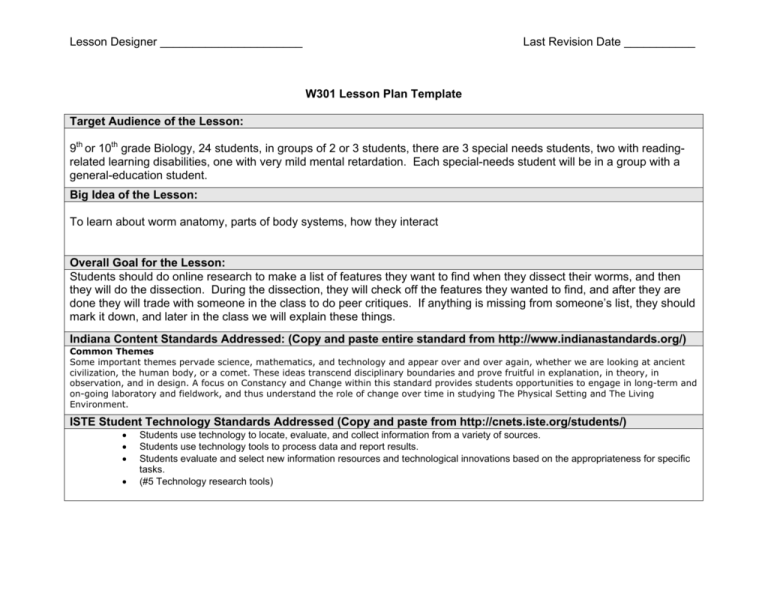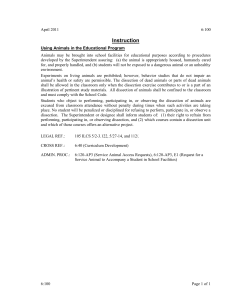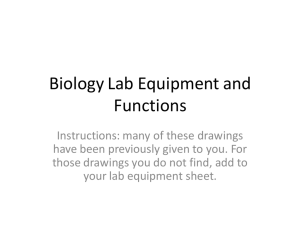Worm Dissection Lesson Plan
advertisement

Lesson Designer ______________________ Last Revision Date ___________ W301 Lesson Plan Template Target Audience of the Lesson: 9th or 10th grade Biology, 24 students, in groups of 2 or 3 students, there are 3 special needs students, two with readingrelated learning disabilities, one with very mild mental retardation. Each special-needs student will be in a group with a general-education student. Big Idea of the Lesson: To learn about worm anatomy, parts of body systems, how they interact Overall Goal for the Lesson: Students should do online research to make a list of features they want to find when they dissect their worms, and then they will do the dissection. During the dissection, they will check off the features they wanted to find, and after they are done they will trade with someone in the class to do peer critiques. If anything is missing from someone’s list, they should mark it down, and later in the class we will explain these things. Indiana Content Standards Addressed: (Copy and paste entire standard from http://www.indianastandards.org/) Common Themes Some important themes pervade science, mathematics, and technology and appear over and over again, whether we are looking at ancient civilization, the human body, or a comet. These ideas transcend disciplinary boundaries and prove fruitful in explanation, in theory, in observation, and in design. A focus on Constancy and Change within this standard provides students opportunities to engage in long-term and on-going laboratory and fieldwork, and thus understand the role of change over time in studying The Physical Setting and The Living Environment. ISTE Student Technology Standards Addressed (Copy and paste from http://cnets.iste.org/students/) • • • • Students use technology to locate, evaluate, and collect information from a variety of sources. Students use technology tools to process data and report results. Students evaluate and select new information resources and technological innovations based on the appropriateness for specific tasks. (#5 Technology research tools) Lesson Designer ______________________ Last Revision Date ___________ Student Objectives for the lesson. (Given a condition, the students will, to what level). Use the internet to do research (some places to look will be given, such as virtual museums), formulate a list/plan for their activity, and use peer critique to evaluate their results. Length of Lesson: (minutes, number of class periods, or days or weeks needed). 4 days (4 class periods, each 90 minutes). This school is in block scheduling, so it will be about 2 weeks for the whole project. Schedule of Activities: (Break down your activity into a timeline of events. Focus on what students will be doing and what teachers will be doing during each part of the activity.) Lesson Designer ______________________ Last Revision Date ___________ Day 1: explanation of the lesson (short lecture, 5-10 minutes plus discussion) and take a trip down to the computer lab. Once there, students will start doing research to find some specific things (picture of worm’s body systems, diagrams showing worm organs, etc). Day 2: students will finish up their research and have something printed out to help them with their dissection. We will then go back to the room to do a quick demonstration of the tools and procedures used during dissection (the teacher will model this activity, but the students will not get to do it themselves until day 3). There will also be a short lecture about safety and proper procedures to use during the dissection. They will be informed that there will be a quick quiz over these the next day. Day 3: start off with safety/lab procedures quiz. Students must pass this quiz in order to proceed, but this could mean that they have to answer any questions that they missed on the paper quiz by speaking with the teacher. For example if they missed #5 but they can answer it correctly after discussing it with their peers, that is enough. The point is to make them accountable for knowing lab safety. After they finish the quiz they will start their dissections. This activity will be guided by the checklists they made, but the teacher can walk around the room and “hover” to make sure the kids are all doing things safely and staying on task. Day 4: they will trade their checklist and observations with a partner and do a peer critique. This will allow them to get feedback (positive and negative, but overall constructive) on their work, as well as see what other people’s work looks like. How will these activities be assessed? (Go back to your objectives, what will the students do? Make sure that each objective is paired to an assessment measure that allows students to show it). Research: each student must have 1-2 pages printed at the end of the research period which contains useful information about what they should find when they dissect worms. Lab Safety: students must pass a safety quiz, know proper lab procedures. Dissection: students will dissect worms and make notes on their observations, what they saw, what they did not see, and keep track of how their observations compare with their research. Peer review: this will allow students to see their peers as valuable resources in scientific endeavors, and foster a sense of community. Adaptations: How might the lesson need to be adapted for students with special needs? Lesson Designer ______________________ Last Revision Date ___________ The lesson could be changed for students with special needs by doing the research portion in partners from the beginning, or small groups. They could still create individual products but they would be made with the input of the rest of the group. Materials Needed: Go through each activity and identify what items (both technology and not) are needed to complete this lesson. Include a breakdown according to individual student or student groups. Computers, paper; Worksheets Dissecting tools, worms (preferably already dead and stored in formaldehyde); Perhaps some tool such as overhead projector to show examples of websites they should use. Websites: http://sps.k12.ar.us/massengale/earthworm_dissection.htm http://biog-101-104.bio.cornell.edu/BIOG101_104/tutorials/animals/earthworm.html http://www.hometrainingtools.com/articles/worm-dissection-project.html Lesson Designer ______________________ Last Revision Date ___________ Alex Shroyer Worm dissection lesson materials: dissection checklist. 1. Place the worm on the dissection table, find which end is the head and which is the tail. Pin the tail to the dissection table. 2. Make an incision along the length of the worm, starting at the tail, and be careful to make it very shallow. 3. Describe what you see after this FIRST incision: 4. Pin back the outer layers of skin and examine the interior. Can you find the hearts, stomach, etc. that we discussed? Does anything appear to be missing? Extra? 5. Discuss with your lab partner what might account for differences in what the book shows and what you see in the lab.





